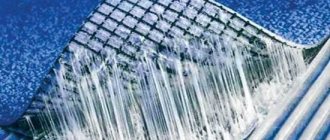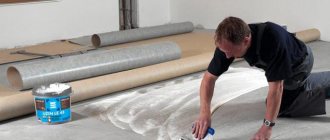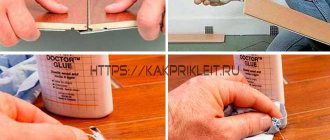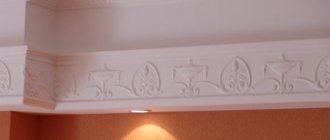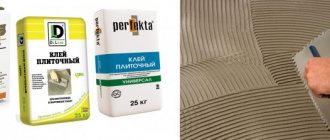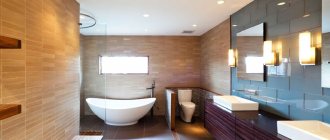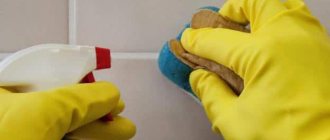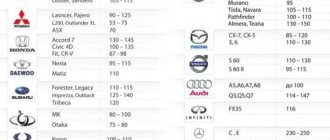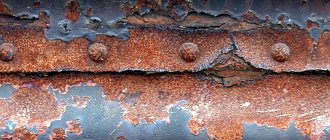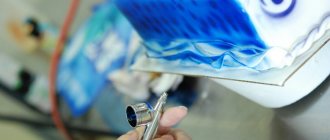Due to its elasticity, linoleum can be damaged quite easily if not handled correctly. In this case, the question arises - how to glue linoleum? Knowledge in this area will also be useful when installing coatings to connect individual panels into a single whole.
Seamless welding of linoleum
How to glue linoleum
Benefits of using linoleum glue
Linoleum is fixed by cold welding, which is carried out using a special glue, and by the hot method using a special cord and a hair dryer. There are also different subtypes of fixation - using thresholds, tape and other materials.
Cold welding is a liquid adhesive that dries quickly. It is sold in tubes equipped with a sharp tip. Due to this, the substance penetrates into the structure of the seams and promotes reliable connection of linoleum fragments. Fixation is carried out at the molecular level. Thanks to this, it is possible to achieve high strength connections. The composition is especially often used for materials that have a foam base. Hot welding for this coating is prohibited.
The key advantages of using glue include the following:
- Possibility of use at home;
- possibility of independent use;
- use for laying coatings and repairing them.
Repair of a broken joint
During operation, the edges of the linoleum in the area where the panels meet may move away from the base. As a result, the seam separates, revealing the subfloor. Debris gets clogged into the resulting cavity, liquid gets in and provokes the proliferation of microorganisms; the raised edges of the covering cause injuries and tears in the linoleum. It is clear that the problem must be resolved quickly.
Be sure to thoroughly clean and degrease the gluing area. Gluing the separated joint is performed using one of the methods presented above. In this case, most likely, you can not consider hot welding due to its rare use in everyday life. It is also not recommended to secure the edges of linoleum with tape - the method can hardly be called reliable and durable.
After studying possible ways to glue linoleum sheets together or correctly make the transition between different flooring materials, you can choose a more suitable option for your conditions. If the necessary work is carried out carefully and error-free, the result will only be positive.
Average score of ratings is more than 0
Share link
Comments There are no comments yet, but you could be the first...
Types and characteristics of adhesive compositions
Today, several types of adhesive compositions are known, each of which is characterized by certain features.
Dispersive
Such substances are made on the basis of water and acrylic. The composition may also contain other substances. They are considered low-toxic and do not have a characteristic odor. At the same time, the compositions can hardly withstand temperature fluctuations and are exposed to moisture.
Acrylate
Acrylic glue can be used to fix heterogeneous or homogeneous linoleum. It is best to choose a frost-resistant and water-resistant composition. In any case, it can be used in rooms with average humidity parameters. In addition, the substance helps fix tiles, concrete structures and other porous materials.
Bustilat
This is a special adhesive mastic that helps hide the seams of a covering that has a felt base. Contains synthetic cellulose. The substance also includes chalk and latex. Therefore, the glue has a characteristic structure similar to paste.
See also
Which adhesive sealant is better to choose for car glass and gluing rules
Gumilax
The substance perfectly fixes the composition on a natural basis. It is made from latex and rubber. The substance is characterized by pronounced viscosity. Working with artificial materials requires the use of an additional felt or textile layer.
Reactionary
Cold welding adhesive is often called reaction adhesive. This is due to a chemical reaction with the linoleum base. As a result, it almost completely melts. This is important for fixing joints, since there is diffusion between coating fragments.
Type A
This glue is characterized by a liquid consistency. It is usually used to fix the joints of laid flooring. If the laying technology is followed, the sheets are securely fastened. As a result, it is possible to obtain a transparent, invisible seam.
The substance should not be used for soft types of coating.
Type C
The glue has medium thickness. It is used to restore the seams of old linoleum. The substance is also used to fix canvases at a distance of 4 millimeters. When applying glue, a stripe appears between the fragments of the coating. As a result, linoleum acquires integrity.
Type T
This type is rarely used. It can be used for synthetic linoleum. The kit includes a T-shaped nozzle. With prolonged storage, the substance loses its characteristics. It can hardly withstand cold or heat. This glue is quite expensive, which is why it is often used for professional purposes.
What it is
Cold welding of floor coverings is a chemical method of joining materials that does not involve the high temperatures associated with conventional welding.
The adhesive composition, entering into a polymerization reaction with the linoleum material, dissolves and melts the edges of the canvases. Their plastic deformation occurs. After completing the process of interaction of the mixture with the coating, a strong seam is formed at the joints of the sheets, and the structure is uniform in structure with the material being joined.
With a high-quality connection of the canvases, the joining seam is not noticeable.
The popularity of using adhesives for joining linoleum cloths of the “cold welding” type is due to the ease of working with them, the relative low cost and the versatility of the method.
Review of popular brands
In construction stores you can find products from different manufacturers. Experienced professionals advise giving preference to reliable brands with a good reputation.
Glue Bustilat Expert
The substance can be used to fix linoleum on plywood, wood or concrete flooring. An excellent solution would be to use it on PVC coverings that have a jute or felt base. It takes a day for the substance to dry.
PVA universal
This product can be used to glue different materials to a wall or floor. It can be used for felt linoleum. The substance costs are low. When applied continuously, no more than 250 grams of the composition are used per 1 square meter.
Polynomial 105
This acrylic adhesive can be applied to any substrate. An indisputable advantage is the short drying period. It does not exceed 12 hours.
Homakoll 208
This adhesive has a water-dispersion base and is suitable for all types of household linoleum. It can be used to fix a substance on a textile basis. The composition is also used for pile or foam coating. The substance does not contain solvents and contains little water.
Thomsit L 240 D
The product can be used for linoleum with a thickness of less than 2.5 millimeters. In this case, the base must be moisture-absorbing.
TYTAN PROFESSIONAL
This glue can be used for all types of PVC. With its help, it is possible to fuse the seams of plastic coatings. The composition contains components such as cyclohexanone, tetrahydrofuran, acetone, polyvinyl chloride.
NORME COLOR PROFI3
The product provides excellent fixation strength. It contains no volatile solvents. The substance is not pressed through by heavy objects. It can withstand continuous loads.
CS "OPTIMIST K503"
This ready-made heat-resistant composition is made on the basis of liquid glass. It contains polymer compounds - latex and thermoplastic. The substance is characterized by a viscous structure, which helps seal cracks and crevices.
See also
The best types of adhesives for installing extruded polystyrene foam
FORBO 522 EUROSAFE STAR TACK
This product is characterized by excellent adhesive ability. The substance is easy to apply. It contains no solvents.
TEX KS CONSTRUCTION
This is a universal heat-resistant product that can withstand temperatures up to 400 degrees. The substance is characterized by excellent adhesion to complex materials. These include glass, concrete, wood.
SINTEX H-44
The composition is used for cold fixation of seams. Thanks to its use, an invisible film is formed. The product prevents shrinkage. It also does not cause the seams to come out in the joint area.
Manufacturers rating
Today there are many well-known manufacturers who produce linoleum.
Homakoll
This company's assortment includes a wide range of products. These include universal compounds and specialized adhesives.
Forbo Erfurt
The manufacturer produces dispersion compositions. Among them you can find glue that is suitable for a specific type of linoleum.
Werner Muller
The company's products are suitable for all types of linoleum. An excellent option would be felt-based and PVC coatings. The composition is also suitable for multi-component materials.
WAKOL
This is a German company that produces an extensive line of linoleum adhesives. They are of high quality and provide excellent adhesion to the surface.
KIILTO
The company produces universal formulations that do not include solvents. The products are suitable for all types of coatings.
UHU
This company's arsenal includes many types of adhesives that help fix linoleum.
To achieve good results, when choosing a substance, you should take into account its composition.
HENKEL
The company produces professional system solutions that are used for arranging floors.
Helpful Tips for Cold Welding
To obtain a durable, high-quality and invisible seam using the non-thermal soldering method, there are several useful tips:
- carefully read the instructions for the adhesive and determine its suitability for working with a specific type of floor covering;
- with liquid compounds, the canvases are joined along an edge cut with the double-cut method - a double cut of overlapping canvases;
- the junction (edges of the canvases) and the base must be cleaned of debris and dust, degreased;
- to protect the edges of the canvas from melting, the seam is sealed with masking tape, followed by a cut in the center;
- the frequency of repeated filling of joints when the glue shrinks should be at least 2-3 hours;
- Before soldering, it is advisable to heat the seam area of hard coatings of semi-commercial and commercial classes with a hairdryer to a temperature of 40°C, but no more;
- To remove glue that accidentally gets on linoleum, you cannot use solvents - only soapy water, and as quickly as possible;
- When filling a seam with glue, you need to use two hands - guide the needle with the finger of one, and hold the tube with the other.
Technology for soldering linoleum
A prerequisite for using reactive adhesives is compliance with safety measures.
Work must be performed in a well-ventilated area, hands must be protected with gloves, eyes with goggles.
To summarize, we can say that cold soldering using high-quality modern compounds is a worthy alternative to other methods of joining linoleum, both in terms of quality and ease of execution.
Criterias of choice
When choosing an adhesive for fixing a floor covering, it is worth considering a number of criteria.
Subfloor type
First of all, you should focus on the type of subfloor. Depending on this, one or another composition is chosen.
Absorbent
This category includes a cement or concrete base. Absorbent coatings also include chipboard, fibreboard, OSB, plywood flooring or solid wood. For such substrates, it is recommended to choose a water-soluble composition.
It is worth considering some features. Board materials can become deformed from excess moisture. Therefore, thick formulations with a minimum of water are suitable for them. Any adhesive will work for concrete.
Non-absorbent
This category includes floors that are lined with natural stone, tiles or porcelain stoneware. In this case, water-soluble compounds will not have an effect, since there is no space for moisture to escape. In this situation, reaction adhesives are suitable. When using them, it is important to follow safety rules - use protective gloves and a mask. Ventilation of the room is of no small importance.
Type of linoleum
Linoleum can be based on different components. There are homogeneous and heterogeneous compositions. Often the coating is made of PVC. It is worth choosing glue taking into account the manufacturer’s recommendations. Gummilak is suitable for foam coating. It provides excellent adhesion and helps avoid damage to the coating. For commercial linoleum with a complex composition, you will need a special substance.
See also
How to properly glue an aquarium at home
How to calculate consumption
Manufacturers indicate on the packaging the approximate glue consumption per 1 square meter. The costs of a substance depend on its type:
- Dispersion glue. The composition includes acrylic and water. 200-300 grams of product are used per 1 square meter.
- Reaction glue. 300-400 grams of product are spent per 1 square meter. At the same time, its varieties - Butylate and PVA - may have higher consumption. It reaches 400-500 grams.
- Special chemical adhesive for cold welding. Type A is characterized by a consumption of 50-60 milliliters per 25 linear meters. The consumption of glue C is 70-90 milliliters per 25 linear meters.
Surface preparation before starting work
To properly glue linoleum, you need a whole range of preparatory work:
- To begin with, it is recommended to clean the coating from dust and debris. Be sure to remove glue, dye, mastic, and stains.
- Remove cracks and irregularities. If necessary, it is worth using mixtures to level the floor.
- Prime the floor. To do this, it is recommended to use a roller.
- Roll out the linoleum sheet on the floor and align it with the walls.
Installation procedure
To apply glue and ensure reliable fixation of linoleum, you should do the following:
- It is recommended to mix the glue in the container well. If a film appears on top, it should be carefully removed.
- Apply glue to the contact surface and level it with a spatula. There should be no untreated areas left on the surface.
- Carefully return the wrapped part to its place. It is recommended to straighten the edges.
- After rolling out, start smoothing. It is recommended to avoid the formation of air bubbles.
- Finally, tap the seams. This must be done as carefully as possible.
Why connect with each other?
Even with the currently existing linoleum flooring up to 5 m wide, not every room has the opportunity to have a seamless floor. Therefore, there is a need for reliable joining of the edges of two or more canvases.
This connection gives the coating additional positive qualities:
- solidity;
- tightness;
- strength of attachment to the base;
- eliminating the accumulation of dirt at the joints;
- improving sound insulation of interfloor ceilings.
Violation of the solidity of non-joined canvases
In addition, the edges of non-joined canvases can be touched when walking, resulting in injury.
